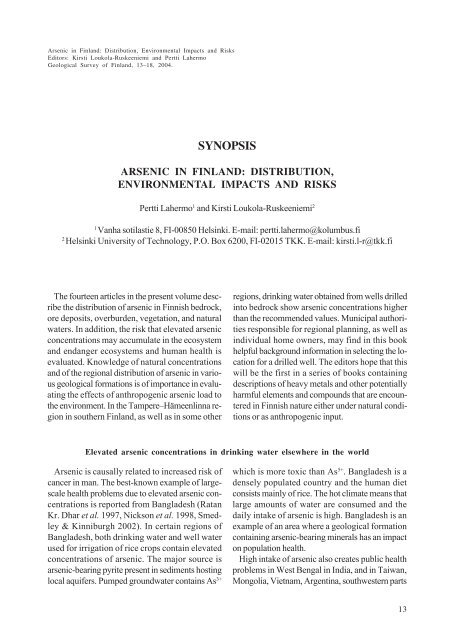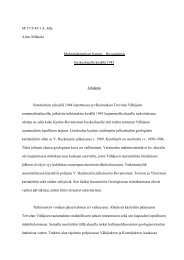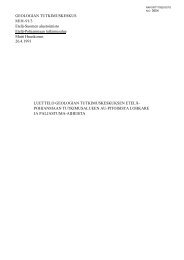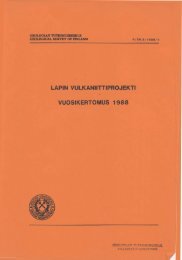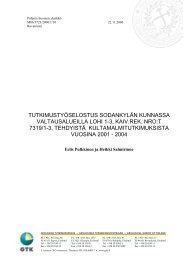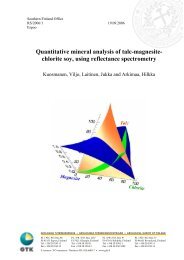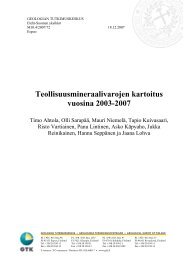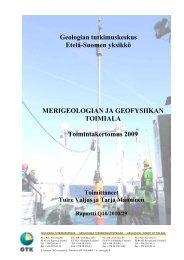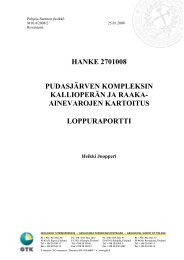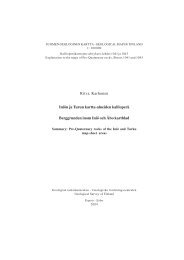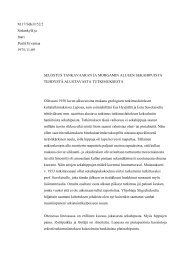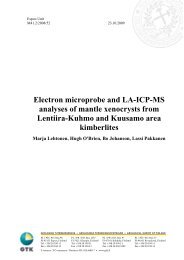arseeni järvisedimenteissä - arkisto.gsf.fi - Geologian tutkimuskeskus
arseeni järvisedimenteissä - arkisto.gsf.fi - Geologian tutkimuskeskus
arseeni järvisedimenteissä - arkisto.gsf.fi - Geologian tutkimuskeskus
Create successful ePaper yourself
Turn your PDF publications into a flip-book with our unique Google optimized e-Paper software.
Arsenic Arseeni in Suomen Finland: luonnossa, Distribution, ympäristövaikutukset Environmental Impacts ja riskit and Risks<br />
Editors: Toimittajat: Kirsti Kirsti Loukola-Ruskeeniemi andjaPertti Pertti Lahermo<br />
Geological <strong>Geologian</strong> <strong>tutkimuskeskus</strong>,<br />
Survey of Finland, 13–18, 2004.<br />
SYNOPSIS<br />
ARSENIC IN FINLAND: DISTRIBUTION,<br />
ENVIRONMENTAL IMPACTS AND RISKS<br />
Pertti Lahermo 1 and Kirsti Loukola-Ruskeeniemi 2<br />
1 Vanha sotilastie 8, FI-00850 Helsinki. E-mail: pertti.lahermo@kolumbus.<strong>fi</strong><br />
2 Helsinki University of Technology, P.O. Box 6200, FI-02015 TKK. E-mail: kirsti.l-r@tkk.<strong>fi</strong><br />
The fourteen articles in the present volume describe<br />
the distribution of arsenic in Finnish bedrock,<br />
ore deposits, overburden, vegetation, and natural<br />
waters. In addition, the risk that elevated arsenic<br />
concentrations may accumulate in the ecosystem<br />
and endanger ecosystems and human health is<br />
evaluated. Knowledge of natural concentrations<br />
and of the regional distribution of arsenic in various<br />
geological formations is of importance in evaluating<br />
the effects of anthropogenic arsenic load to<br />
the environment. In the Tampere–Hämeenlinna region<br />
in southern Finland, as well as in some other<br />
regions, drinking water obtained from wells drilled<br />
into bedrock show arsenic concentrations higher<br />
than the recommended values. Municipal authorities<br />
responsible for regional planning, as well as<br />
individual home owners, may <strong>fi</strong>nd in this book<br />
helpful background information in selecting the location<br />
for a drilled well. The editors hope that this<br />
will be the <strong>fi</strong>rst in a series of books containing<br />
descriptions of heavy metals and other potentially<br />
harmful elements and compounds that are encountered<br />
in Finnish nature either under natural conditions<br />
or as anthropogenic input.<br />
Elevated arsenic concentrations in drinking water elsewhere in the world<br />
Arsenic is causally related to increased risk of<br />
cancer in man. The best-known example of largescale<br />
health problems due to elevated arsenic concentrations<br />
is reported from Bangladesh (Ratan<br />
Kr. Dhar et al. 1997, Nickson et al. 1998, Smedley<br />
& Kinniburgh 2002). In certain regions of<br />
Bangladesh, both drinking water and well water<br />
used for irrigation of rice crops contain elevated<br />
concentrations of arsenic. The major source is<br />
arsenic-bearing pyrite present in sediments hosting<br />
local aquifers. Pumped groundwater contains As 3+<br />
which is more toxic than As 5+ . Bangladesh is a<br />
densely populated country and the human diet<br />
consists mainly of rice. The hot climate means that<br />
large amounts of water are consumed and the<br />
daily intake of arsenic is high. Bangladesh is an<br />
example of an area where a geological formation<br />
containing arsenic-bearing minerals has an impact<br />
on population health.<br />
High intake of arsenic also creates public health<br />
problems in West Bengal in India, and in Taiwan,<br />
Mongolia, Vietnam, Argentina, southwestern parts<br />
13


